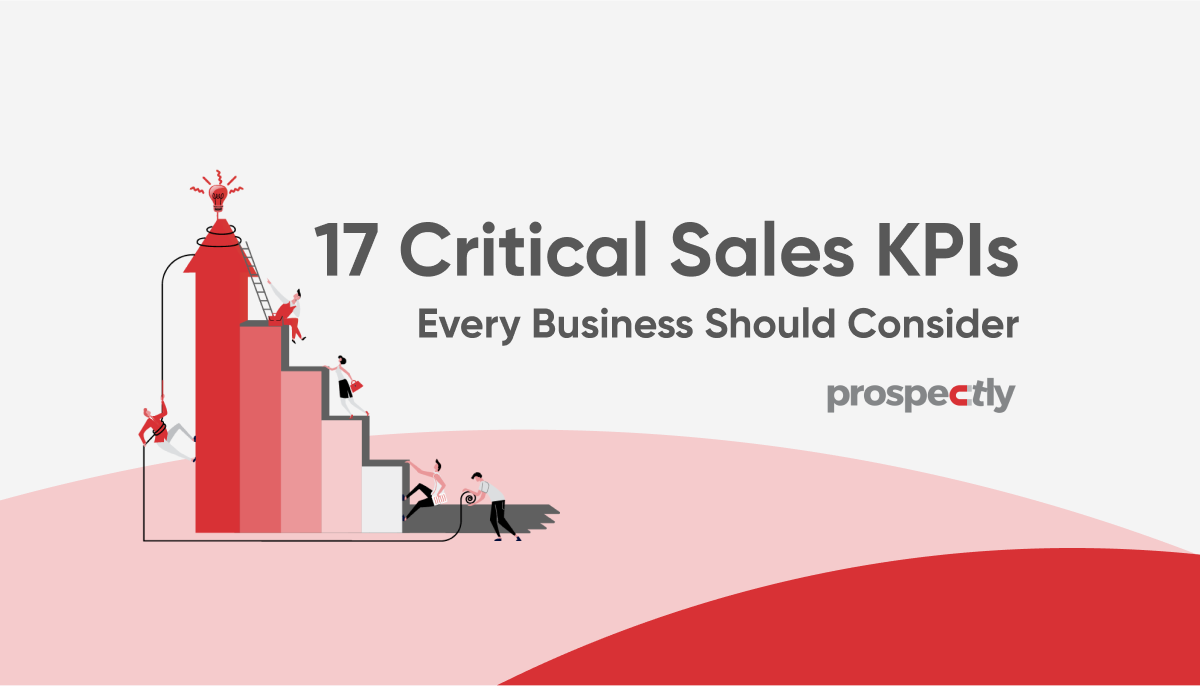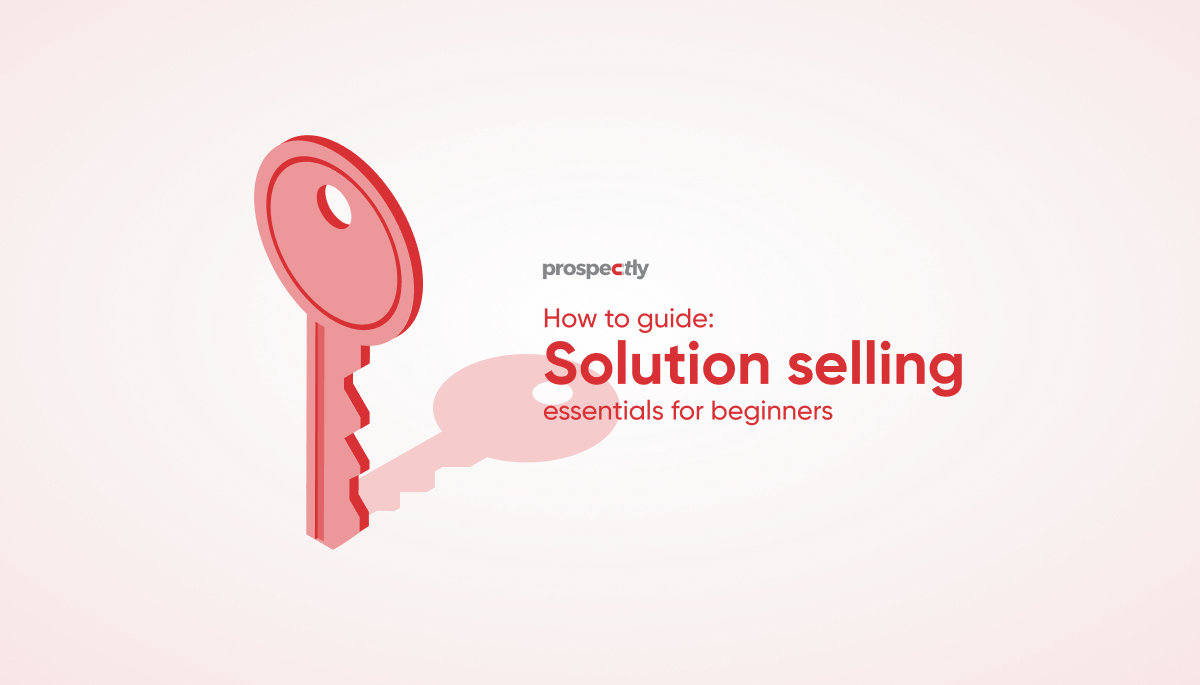Unraveling your ideal sales hiring strategy: A complete guide

If you are a sales manager or responsible for sales hiring, you would be attuned to the high turnover rates in your profession. According to HubSpot, the average sales turnover is a whopping 35%, which is three times higher than other functions. Additionally, for 45% of B2B sales companies, the turnover rate is more than 30%. Hence, to proactively avoid an understaffed sales team, you must hire quality resources consistently. This blog will mainly focus on refining your sales hiring strategy, which drives your company’s revenue success.
Why do you need a sales hiring strategy?
It is fair to say that the realities of the virtual working environment have significantly transformed sales recruitment. The traditional sales skills that were once considered ‘great to have’, are now the bare necessity. Today’s employers are looking for candidates with contemporary skills like technically adept salespeople or sales reps with a flair for data analysis to thrive in the digital sales revolution.
A study by Harvard Business Review indicates that turnover directly impacts your company’s sales. The time taken to refill vacant sales positions and that the salesperson requires to learn the tricks of the trade will affect your business goals.
A sales hiring strategy will save you the time and resources spent training bad hires or flight-risk employees. Let’s explore how to ideate the perfect sales hiring strategy for your company.
Building a viable sales hiring strategy with the ‘3Ws and an H’ framework
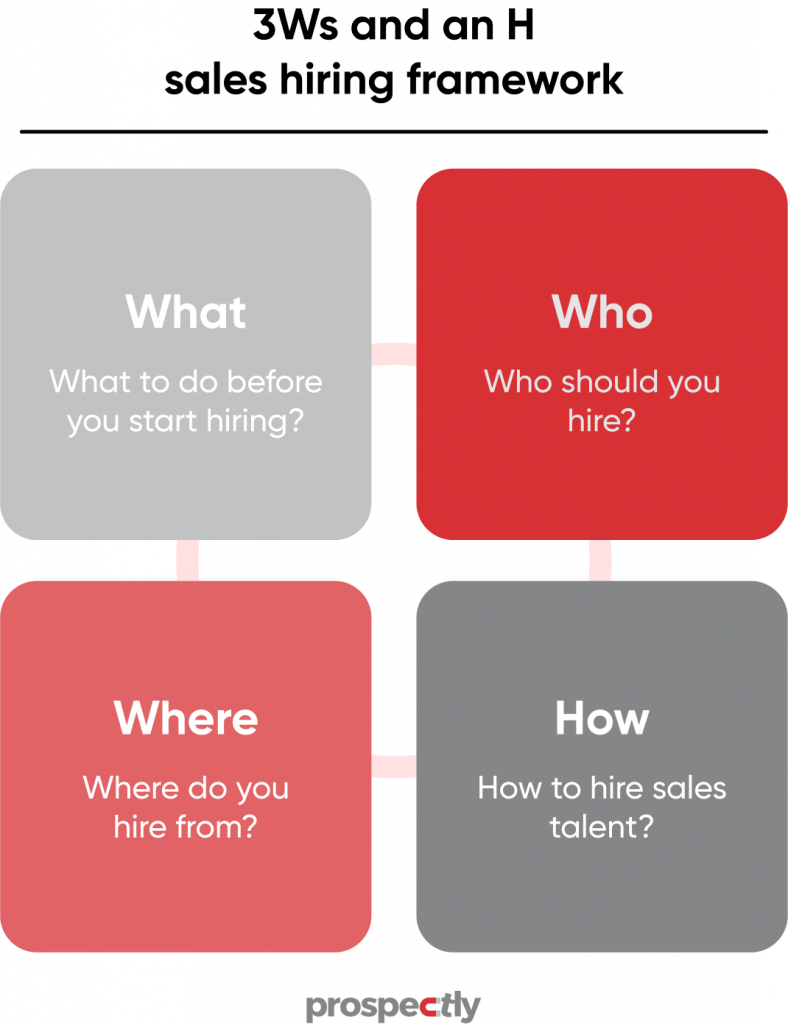
To create an outstanding hiring process that aligns with your business goals, this blog will elaborate on the ‘3Ws and H’ sales hiring framework. It will help you outline What to do before you start hiring, Who is the best candidate for your business model, Where do you find the perfect salespeople for your brand, and How do you hire top talent.
What to do before you start hiring?
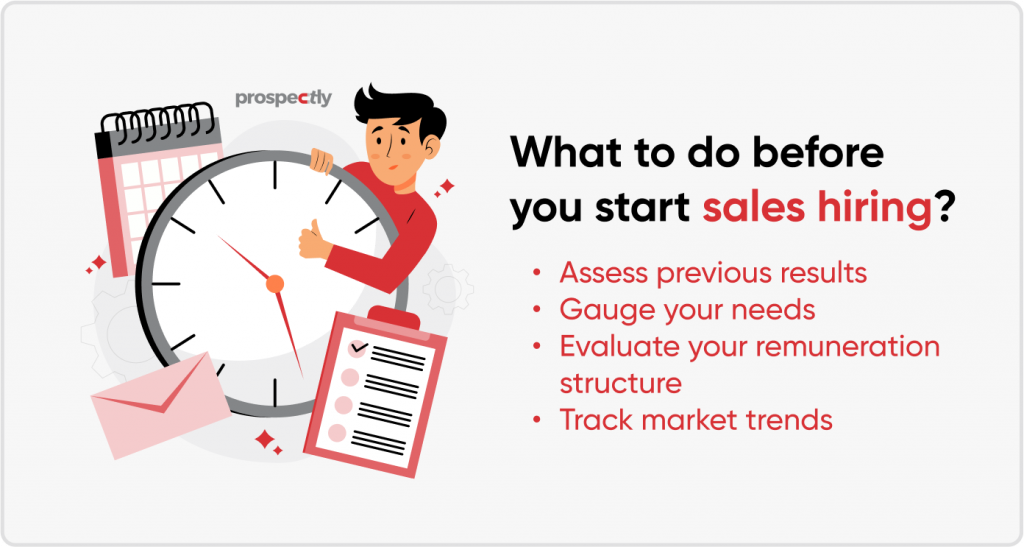
For your hiring strategy to yield the expected results, you need to check a few things off your list.
Assess previous results
Carefully review your last sales hiring process and the performance of that batch. Answer the following questions before you determine your hiring cycle.
- Do your employees meet the criteria they were hired for?
- Were there any gaps in your hiring process that have affected your sales performance?
Gauge your needs
Before embarking on this journey, be mindful of your goals and hire accordingly.
- If you plan on expanding to a new market, it would be better to hire experienced sales staff.
- Is your sales team scheduling more meetings than they can handle? Do you think you are short-staffed to achieve your projected growth? If your answer to these questions is yes, you could hire some fresh blood to help with operational tasks.
Evaluate your remuneration structure
Often, the primary reason for choosing sales as a profession is the lucrative compensation and performance bonuses. Determine if you are at par with market salary trends. If not, tweak your remuneration structure and make sure it is enticing enough to attract skilled salesforce.
Track market trends
If you have been following industry trends, you would be aware of the skill sets you need to service your current customer base. For instance, virtual selling has lifted geographical limitations and enabled you to expand your target market. However, to service your remote clients, you will need sales reps with specific skill sets, like digital dexterity, experience with online client engagement, etc. It’s time to look for new talent with fresh skills if you find it lacking in your team.
Who should you hire?

Once you have decided that you are ready to start hiring, you need to ascertain the winning qualities you are looking for in your ideal sales rep. The following actionable steps can help in this regard.
Profile ideation
To craft the profile of your optimal sales candidate, you need to consider the overarching traits that serve your mission.
- Analyze your high-performing sales reps and identify their dominant characteristics, selling styles, industries they come from, etc.
- When looking for sales skills, ensure your prospective employees have the right balance of hard sales skills for winning deals, soft sales skills for relationship building, and digital sales skills to keep pace with your technically savvy clients.
- If you are looking to hire for different sales positions like demand generation, customer success, etc., make sure you screen for the inherently role-based attributes.
For a comprehensive guide on critical sales skills categorized by hard skills, soft skills, digital skills, and role-based skills, review our blog 26 non-negotiable sales skills every salesperson should have.
Drafting your job description
After drilling down the critical skill sets of your next high performer, it is time to put pen to paper and draft an alluring job description. However, you need much more than a generic JD to attract desirable candidates.
Highlight your EVP (Employee Value Proposition)
Employee value proposition is a collection of unique advantages employees receive from a company. Having a solid EVP on par with the ever-changing workforce dynamics helps you attract and retain top talent. Your JD should accentuate your USP.
Keep it clear and precise
Stay away from jargon and articulate what you are looking for. Smart salespeople are can read through the vague descriptions and are mostly looking for companies that project authenticity.
Be realistic about your expectations
When describing your candidate profile, do not chase after perfection. Your JD should reflect practical traits and achievable goals. You can categorize your list of desired skills into the following buckets.
- Must-haves – compulsory for the position
- Good-to-have – added advantage but not necessary
- Can’t-have – will not be accepted or does not align with your company culture
Nail down your JD template
Designing job description templates for each sales position will make the hiring process much more streamlined. Here’s a sample template for the role of Account Executive.
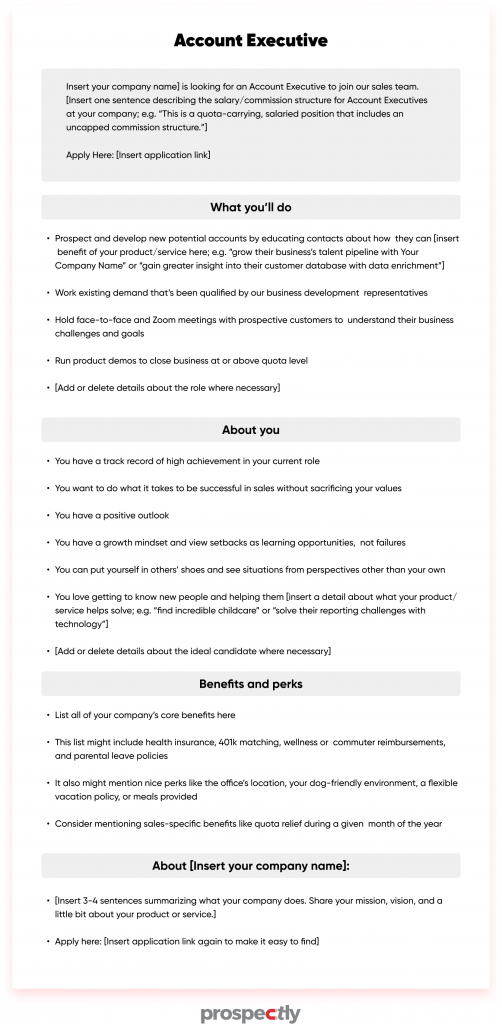
Where can you find your ideal sales candidate?
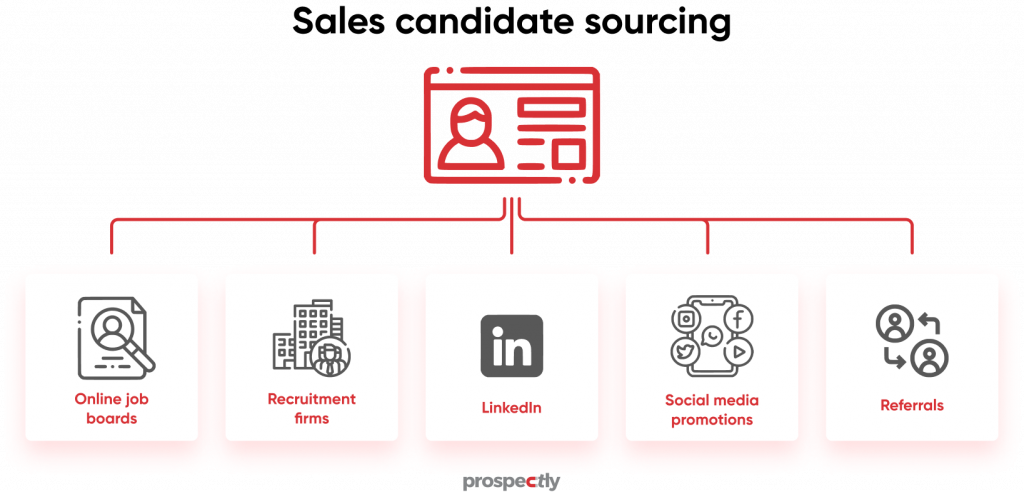
In today’s digitally connected world, sourcing is not limited to postings on conventional job boards. Yet, with multiple choices, headhunting can seem daunting. The key is to try out several options and decide on the best ones for your company.
Here is a list you could consider.
Online job boards
The tried and tested job boards like Monster, Glassdoor, Indeed, etc., work best when looking for mass hiring. However, do note that these sites can often provide a high number of unqualified aspirants, and hence you will need to do your due diligence during the screening process.
Recruitment firms
Independent recruiters or staffing agencies are a good source for filling up critical positions urgently. But they usually charge steep fees for customized services. So this may not be a viable option should you have budgetary constraints.
This is the best place to identify sales candidates based on specific filters like skills, industry, years of experience, etc. Although effective, this process is time-consuming. The best salespeople are often employed and not available. In addition, you will need to reach out individually to each of them, making the hiring process even longer.
Social media promotions
Advertising open positions on social channels is a highly cost-effective and efficient sourcing process. It also has a much broader reach and a faster response rate.
Referrals
Reaching out to your connections can be an excellent option to source trustworthy qualified sales employees. Research indicates that 50% of hires onboarded through the referral process stick to a company for more than three years compared to 14% sourced from job portals.
How do you hire qualified salespeople?

So now that you have a constant inflow of resumes based on your JD from your preferred source, it’s time do the actual groundwork. Try not to opt for short-cuts at this stage. Considering the exorbitant costs of bad hires, it’s better to invest in a tailored long-term approach rather than focusing on quick gains.
Screening
Screening applicants before the actual interview helps you separate the wheat from the chaff. You can filter interviewees via phone/video call or written assessment.
Phone/Video call
Screening a candidate over a call with help you assess their key skills like rapport building, real-time objection handling, etc. For instance, you can test their hard sales skills by asking them to take you through a lead generation, and sales funnel they are familiar with.
Take a look at these sales hiring questions.
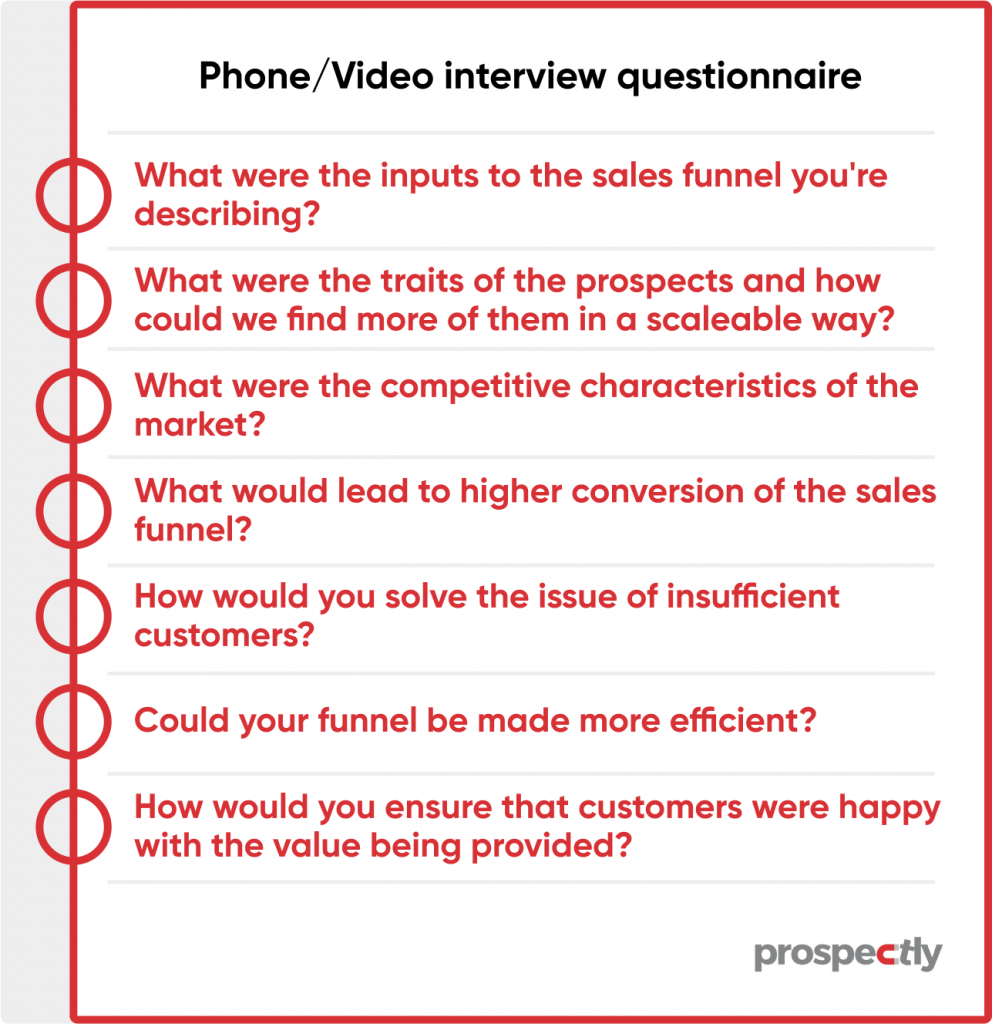
Written assignment
This process helps you test written communication skills, critical thinking, personality fit, and commitment to the interview. You can try sending out a few open-ended questions to better understand the applicant’s abilities.
You can take some ideas from the below questionnaire.
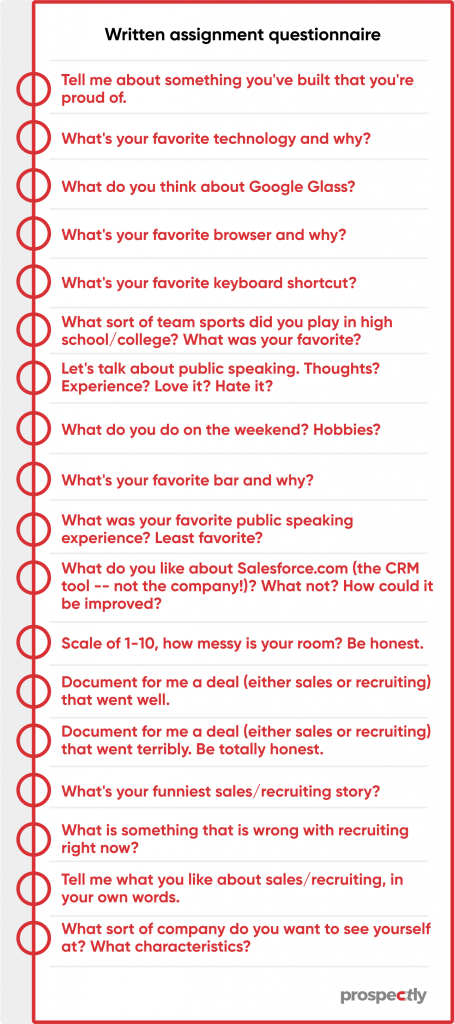
Mock demo
If you are hiring for client-facing sales roles, conducting a mock demo is a good test for presentation skills. You can schedule the demo during the screening process or make it a part of the primary interview.
Advise the interviewees to treat the mock demo as a real-life prospect scenario. You can ask them to sell you a product that would be useful to your company and judge them on the following metrics.
- Calendar invite sent before the demo with meeting details (time, date, meeting link, agenda)
- Meeting reminder email/call
- Confidence displayed in the demo
- Background research about your company
- Customizing the product/service to suit your company’s needs
- Keep the meeting interactive by asking probing questions, checking for any doubts, follow-up questions, etc.
- Objection handling during the presentation
- Competitive analysis
- Ability to manage a challenging customer
- A strong finish
- A follow-up call/email with the proposal, preferably within a day of the demo
Interview
Now that you have your cream of the crop, it’s time for personalized interviews.
Interview structure
Without a structured interview process, you are less likely to identify a proper fit.
- Use sales hiring scorecards with an identical set of questions for each interviewee.
- The scorecard metrics should represent the traits of your high performers.
- Score job-seekers based on a grading system against each metric.
- If multiple team members are conducting the interview, they should use some variation of the same scorecard for deciding objectively.
Team interviews
Before welcoming a new employee into the team, it is crucial your team members get to know the person and validate the new hire. Each team member who interviews the candidate should have a specific agenda. For e.g., an account manager can gauge your candidate on their relationship-building skills, an operations manager can test them on their technical know-how, etc.
Interview questions
The interview questions should cover the following areas.
- Expertise in hard sales skills like business acumen, buyer research, client engagement, etc.
- Personality and behavior
- Motivations
- Practical experience
- Ability to deal with hypothetical situations
Answering candidate queries
A goal-oriented salesperson will want to know more about you and your company before accepting an offer. Be prepared to answer questions on your company culture, compensation and commission structures, success metrics, sales enablement tools used, growth trajectory, etc.
Making an offer
Now that you have gone through this exhaustive checklist to finalize the best-suited salespeople for the job, it’s time to make the offer. Here are a few things to consider during this stage.
- Have a group discussion with your hiring team and consider each point of view. If you or your team have any doubts about an aspirant at this stage, they most probably don’t fit the bill.
- When deciding between multiple strong candidates, the rule of thumb is to assess them against each other. You can do the resilience test where you offer constructive criticism on written and verbal tests to evaluate their reaction. The candidates that stay cool under pressure and can hold their ground are often the ones that can stand the test of time.
- It is natural for talented salespeople to negotiate on compensation as it’s an innate part of who they are. The decision is ultimately yours and is based on various factors like your sales team’s structure, budget, management approvals, etc.
- Make the offer by email or phone and proceed with the official formalities once they accept the offer.
- Notify those who did not qualify. This shows integrity on your end and is a good practice to stay connected for future opportunities.
Onboarding
This is the stage where you want to make haste. Top candidates will not remain in the market for a long time, so the sooner you onboard, the better. A solid onboarding process is key to retaining your high performers for the longer run.
Use the initial months to empower your new hires by introducing them to the team and company culture, training them on products/services, and slowly involving them in your sales process.
Reflect and reassess
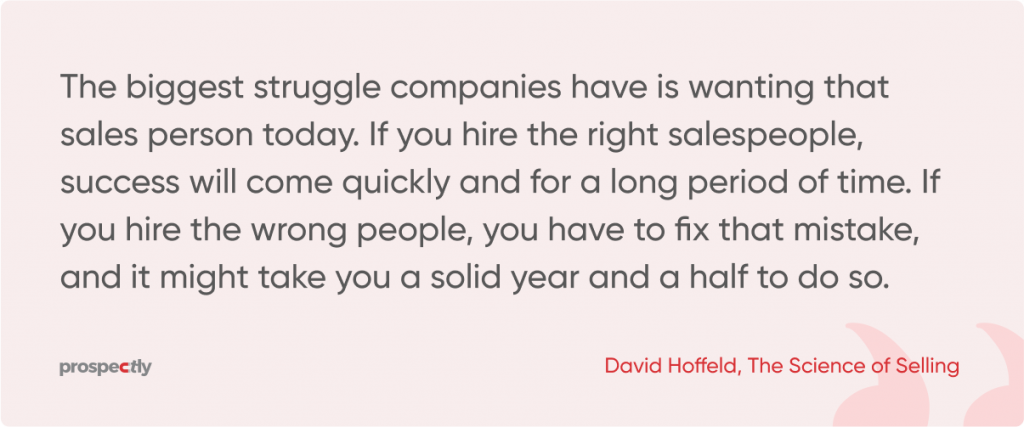
To execute successful hiring cycles, it is paramount to evaluate every aspect of your hiring process. For future recruitments, do more of what worked best this time and eliminate less successful practices. E.g., if your best hires from this season came from social media promotions, invest more in this avenue and minimize unnecessary spending on recruitment firms. If a combination of written screening tests and mock demos results in better talent but a longer hiring timeline, you might want to adjust your expectations accordingly.
Ultimately, investing time and resources to design an agile sales hiring process will boost your revenue and improve retention rates. Constantly measuring and improving your recruiting efforts are the catalysts to building a winning sales team.
